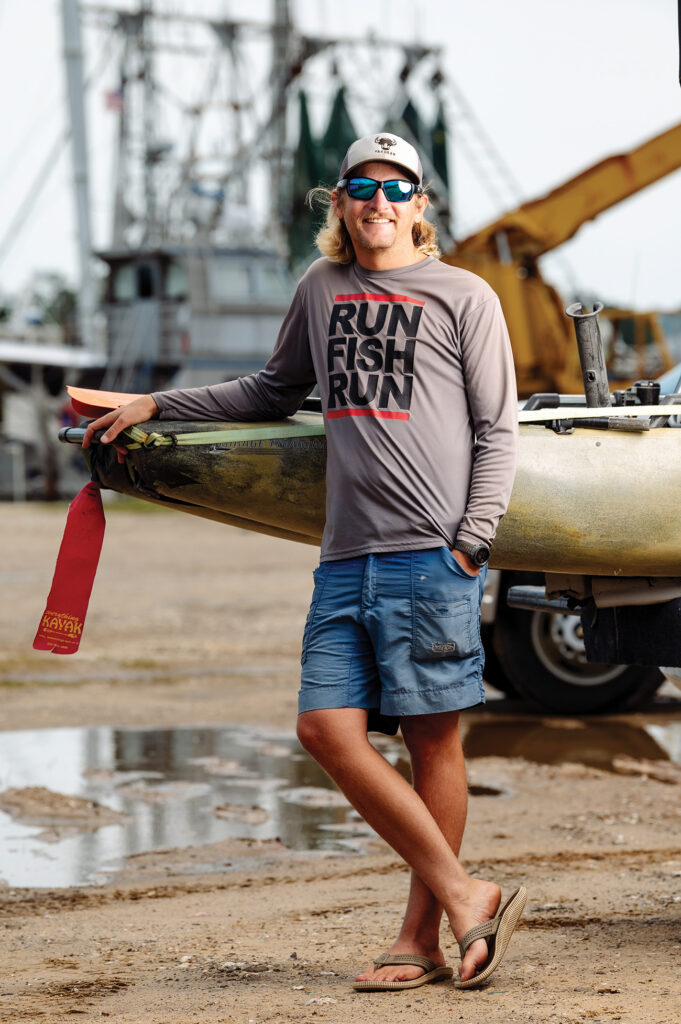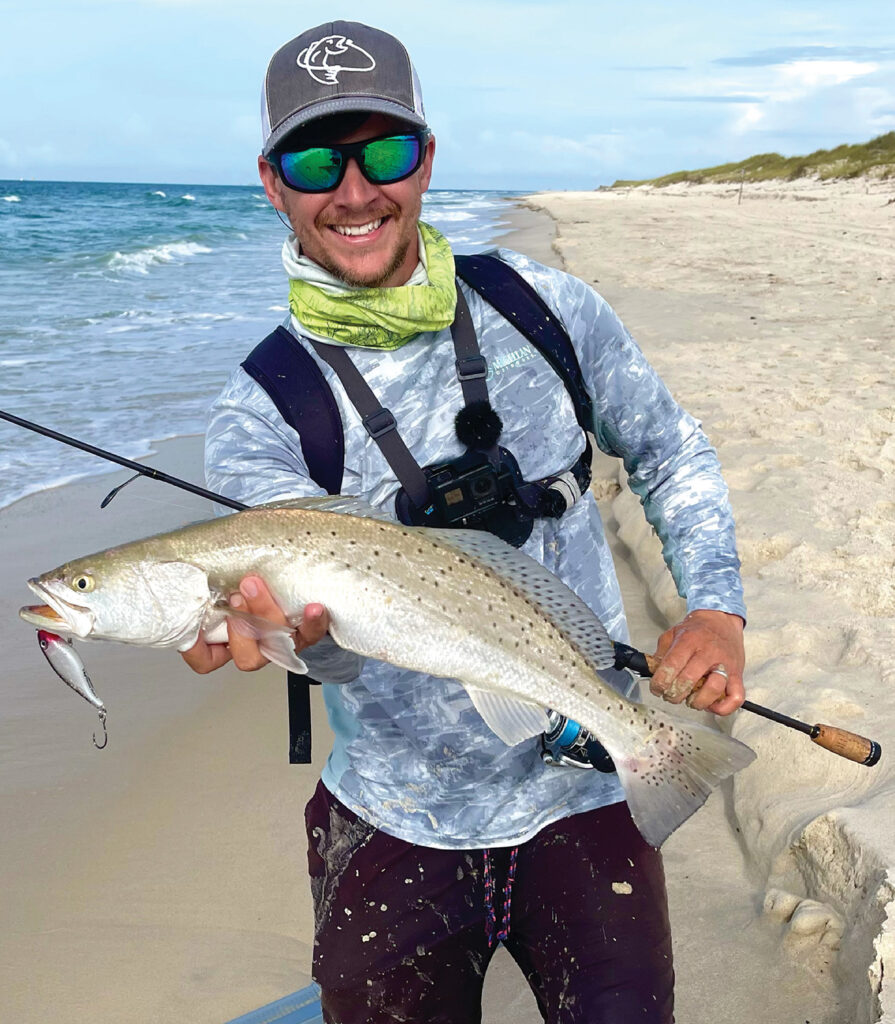
Scott Kennedy answers the phone at his home in Bon Secour, where he’s editing a video about sight casting in Alabama.
“I just filmed the introduction to the video, explaining step-by-step what I do as far as gear and bait,” he says. “Then I’ll combine that with some fishing footage I shot about a week and a half ago.”
The 28-year-old says most people don’t realize just how time-consuming this part of the process is; editing a 20-minute video is at least an eight-hour undertaking, and that doesn’t take into account the other eight hours it took to shoot the footage from his kayak. Kennedy realizes, however, that it’s a small price to pay for doing what he loves. When he uploads this video, entitled “How to Sight Fish,” his more than 9,000 YouTube subscribers will get a notification. Later, he might repurpose a clip from the same video for his 11,800 followers on TikTok.
When most people envision a social media influencer, they don’t picture a kayak fisherman. But Kennedy is part of an ever-growing class of content creators — outdoor enthusiasts who have discovered that they can make a living documenting their adventures in the great outdoors.
Before calling Kennedy, I found one of his videos on YouTube, posted under his account Kayaking_Kennedy. In it, he’s standing in his kayak, sight casting for redfish near the Perdido Pass. He lands one fish, speaking to the GoPro camera on his head as if you’re there in the boat with him. He lands a second, larger redfish and tells you what he thinks about the wind that day, the water temperature. The sound of the seagulls and waves fill my headphones. The video ends. I click another one.

When I finally meet Kennedy at a boat launch in Bon Secour, he’s exactly the same guy in those videos. He leans against the bed of his truck, where his Hobie kayak is tied down, and laughs like a man who fishes for a living. He wards off the sun with a long-sleeve T-shirt that reads “Run Fish Run,” a trucker’s hat, sunglasses and blond hair that touches his shoulders.
“My dad and grandpa, pretty much all of my family, were big fishermen,” he says, talking about his Daphne upbringing. At the age of 16, Kennedy found that a driver’s license and a kayak was a passport to the world.
“I was able to take that kayak out every single day,” he remembers. “I could leave it in the back of my truck, and as soon as I got out of school, I could hit the water.”
After attending Auburn and moving back to the Alabama coast, Kennedy spent a few years working at local marinas — pumping gas, replacing dock boards, working boat shows and billfish tournaments. “I enjoyed the job,” he says. “I got to be around boats every day. I was on the water every day. But you know, I had to watch all these other people fishing.”
It was his girlfriend Karen (now his wife) who first came up with the idea. “She said, ‘All this stuff you’re doing in your kayak, people online would probably love to see that,’” he remembers. Kennedy bought the cheapest GoPro camera he could find, taught himself the basics of video editing, and over a couple years, people started tuning in. He eventually had enough viewers asking him for guided kayak trips that he could leave his job at the marina and start guiding full-time.
“It was incredible to be able to do what I enjoy and fish every day and make a living off of it,” he says. “It definitely made waking up in the mornings a lot easier.”
He made that switch about five years ago. These days, Kennedy is still guiding and making kayak and surf fishing videos. He describes his channel as a place where someone can see “all types of fishing along the Alabama Gulf Coast, with a little bit of travel blog mixed in.” He’s found that many viewers watch for simple enjoyment, to check out of work for a while and transport themselves to a kayak. Others watch to fine-tune their own fishing skills, and Kennedy focuses his attention on anticipating their questions.
“Throughout the videos, I try to explain what I’m doing and why I’m doing it. Why did I stop and fish this area? Or why am I throwing this color bait today instead of the bait I threw two days ago? I try to kind of paint a picture so somebody can just go out one day and give it a shot.”

Although he releases most of the fish he catches, he and Karen eat his catch about three nights a week: redfish, speckled trout, flounder, sheepshead. On calm days, he even ventures into the Gulf in search of red snapper, king mackerel or mahi-mahi.
But fresh fish isn’t the only perk of being an outdoors influencer. Once a YouTube channel reaches a certain size, a creator can activate monetization, earning revenue for those 15-second ads at the beginning of videos. Sure, Kennedy only makes fractions of a penny per ad view, but when those views start piling up, the result is a career in kayak fishing.
Of all the content he’s created, Kennedy’s most-viewed video, to his amusement, is a TikTok clip of him accidentally flipping his kayak while reaching for a dropped rod. It currently sits around 700,000 views. Another popular video captures the moment when Kennedy falls off his kayak reaching for his phone as it tumbles into the water. “That seems to be a theme — me dropping stuff over the side of my kayak.”
Besides being hilarious, such mishaps are incredibly relatable and likely contribute to Kennedy’s popularity. Nobody is immune from doing something silly on the water, and it’s hard not to like a guy who puts those moments online for the world to see. He gets recognized often, at the boat launch or coming off the beach after an outing. “We usually sit there and geek out about fishing for a little while,” he says. “It’s always nice meeting somebody who recognizes me. It’s always kind of humbling.”
How Influencers Earn Money
Ad revenue: Once a content creator’s audience reaches a certain size, websites like YouTube and Facebook will auction off advertising space to companies who want to put ads on a creator’s videos. Although it varies by influencer and social media platform, it’s not unusual for a content creator to earn anywhere from $3 – $12 per 1,000 views their videos receive.
Short-form content: This growing aspect of social media (think Instagram Reels) features video clips of 60 seconds or less. Platforms like TikTok, Instagram, Facebook and YouTube pay creators every month based on view count.
Sponsorships: Many creators are paid directly by companies to add a 30-second or one-minute promo to their videos.
Affiliate Programs: Creators will often provide a personalized link or promo code for a certain product. If their viewers buy that product using the link or code, the creator receives a commission.
Merchandise: Some creators sell their own branded products (i.e. fishing rods, hats, T-shirts) online.

Matthew Isbell, aka Bama Beach Bum, gets recognized, too. A lot. It’s hardly surprising; the Gulf Shores resident has more than 108,000 followers on his YouTube channel and another 11,000 on Instagram.
“Yeah, it’s … pretty weird,” he says. “Even my wife and daughter and my mother-in-law — all of them, wherever they are, now get recognized.”
The 34-year-old Isbell, who hails from Wetumpka, Alabama, grew up hunting and fishing with friends, but says he wasn’t a serious outdoorsman until adulthood. “I was selling life insurance, and I did that for about 10 years,” he says. Ready for a change, in 2017, Isbell was watching some fishing videos, and a thought occurred to him. “I saw these people who seemed to be doing well — you know, earning a living making online content. And I thought, ‘Well, I’m fishing anyway. I might as well film it and post it. Maybe in a year or two, I’ll be making enough money to pay our rent.’ I made a commitment when I first started to post one video a week and not let off the gas.”
In just seven months, Isbell was able to quit his insurance job and become a fishing guide, thanks to the popularity of his videos. Now, he’s built a sizeable audience in the saltwater fishing world by primarily posting pier and surf fishing videos about the Alabama Gulf Coast. He no longer guides, preferring instead to focus on creating fun, educational and attention-grabbing content; his most recent video is titled “Fishing the BEACH with 25 RODS!! **They said, DON’T DO IT**.”

While a lot of Isbell’s viewers are watching out of curiosity (who wouldn’t click that video?), many are watching in hopes of wetting a hook themselves. Like Kennedy in his kayak, Isbell is selling an accessible form of fishing. “It’s not limiting,” he explains. “It’s not like you have to have a sport fisher to go 100 miles out and catch tuna. You can just get a couple of rods, whatever you’ve got in the garage, set up a couple of sand spikes, throw out some dead shrimp and fish bites on the beach, and you’re fishing.”
One misconception about being an outdoors social media influencer is that it’s all sunshine and shrimped hooks. The truth is that being self-employed, and creating as much content as Isbell does, is a ton of work.
“It’s definitely seven days a week, 365,” he says. “It doesn’t feel like work, but you’re always working.” These days, Isbell tries to release three videos a week, but that doesn’t always happen. He has to work around poor weather conditions, and sometimes a day of fishing just doesn’t yield enough action. But for every day of frustration and at-home editing there’s a day of thrill and action — a rediscovery of what pulled Isbell into this career in the first place. On the best of days, that message is delivered by way of a jack crevalle.
“Jack crevalle are my favorite fish to target,” he says. “They’re just the hardest, baddest fish we’ve got around here. They give me everything I want out of a fish: intense eats, intense fight, they don’t quit. I love it.”





